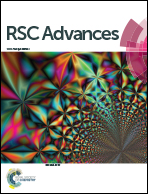Encapsulation of therapeutic lavender oil in an electrolyte assisted polyacrylonitrile nanofibres for antibacterial applications
Abstract
Electrospinning, a feasible nanotechnology, has been exploited to engineer polyacrylonitrile (PAN) nanofibrous mats enclosing a representative hydrophobic drug like essential oil of lavender. The incorporation of electrolytic solution (NaCl) to polymer solution enhanced the electrospinning capability. Concentration as small as 0.3% (w/w) of electrolyte resulted in significant nanofibre morphologies, reduced average fibre diameter (88.44 nm) and it exhibited a narrow degree of polydispersity. The dosage of drug loaded in PAN nanofibres were varied from 12.5 to 200 μg mL−1 and their cytotoxicity against mouse fibroblast NIH/3T3 were studied in vitro. The antibacterial proficiency was gauged by challenging the material against Staphylococcus aureus and Klebsiella pneumoniae bacteria. The PAN nanofibres exhibited effective bactericidal properties of 14–15 mm zone of inhibition in at least 8 h, and it remained unaltered over 30 days. The in vitro release of the drug resulted in a dual drug release profiles with an initial burst as well as the diffusion dominated release, ensuing an enduring antibacterial activity. The incorporation of lavender oil improved the thermal stability resulting in a 20% residual mass at 800 °C, higher than pristine PAN nanofibers. The modelling of the interactions between PAN and the major antimicrobial components of lavender was performed to understand the chemistry between the additive and polymer. Thus, PAN nanofibres can be used to be a promising antibacterial material in various fields like biomedical, textile and water treatment applications.


 Please wait while we load your content...
Please wait while we load your content...